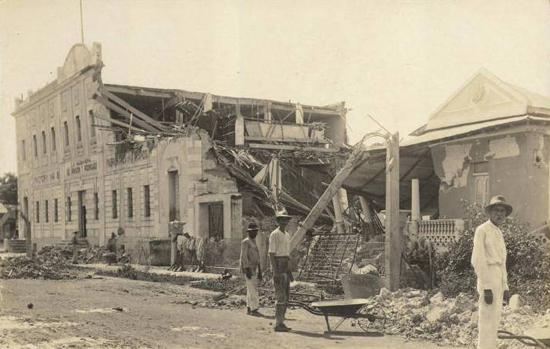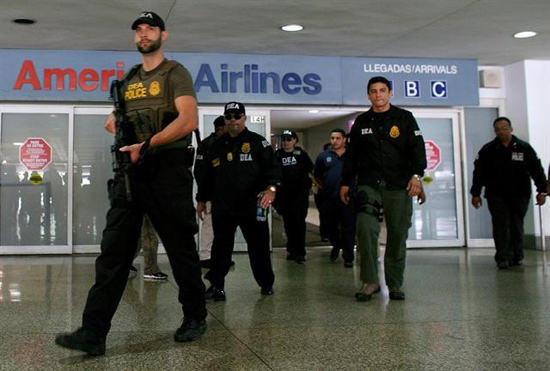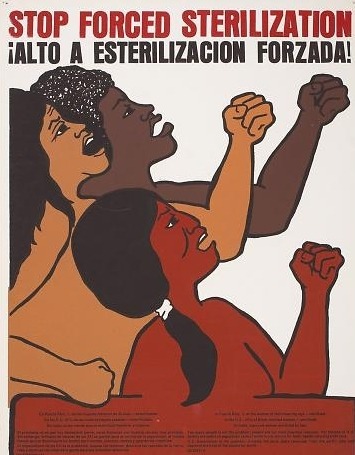
by Jose Alvarado Vega
A moderate earthquake struck Puerto Rico early Sunday morning, damaging buildings and rousing residents from their sleep throughout the island. No injuries were reported.
The 5.8 magnitude earthquake, which struck at about 1:16 a.m., was centered four miles northeast of the Moca inland community of Espino — latitude 18.4 north, longitude 67.07 west — at a depth of about 67 miles, according to the U.S. Geological Survey. It was felt as far west as the Dominican Republic and as far east as the U.S. Virgin Islands.
Christina von Hillebrandt-Andrade, director of the National Oceanic and Atmospheric Administration’s Caribbean Tsunami Warning Program, said that there was no danger of a tsunami since the earthquake occurred on land and had a magnitude of less than 6.5 on the Richter scale. However, “many residents” on the Mayagüez coast fled to higher ground fearing the worst, she said.
The quake cracked the walls, ceilings and foundations of homes and office buildings in the municipalities of Florida, Lares, Moca, Utuado, Yauco, Aguadilla, Jayuya, Ponce and Vega Baja, State Emergency Management and Disaster Administration Agency Heriberto Saurí said during a press conference later in the day.
The quake spilled rocks over a highway in Utuado, where it also shifted a concrete house some four inches from its foundations. The single bed-ridden resident of this home was removed as a precautionary measure, Saurí said.
In Ponce, the balcony of a house on Third Street in Barriada Clausell collapsed.
Engineers were trying to determine if other damaged homes were safe, Saurí said.
Due to the nature of seismic waves, the earthquake was felt more strongly by people living on land-filled grounds, in higher elevations and in high-rise buildings, Hillebrandt-Andrade, who also headed the Puerto Rico Seismic Network, said during the press conference.
In fact, residents of the San Juan metro area, about 65 miles from the earthquake epicenter, were frightened by the strong shaking. People who felt the earthquake told the Daily Sun that they first felt a slight swaying that grew into heavier trembling that lasted about a minute.
Many said that they had not felt such a strong earthquake in years, if ever, and expressed fear given the January 12 earthquake in the neighboring Caribbean nation of Haiti killed more than 200 thousand people.
Carolina Municipal Police reported that 30 residents, including children, of the Torres de Sabana public housing complex evacuated their apartments and feared returning to their homes because they heard on the radio that an earthquake of greater magnitude could follow. The residents, gathered at the parking lot of an automobile products establishment, were not moved by the clarification made by Carolina Emergency Management Official Juan Morales, who said that no such warnings had been issued.
Vanessa Torres, 39, a resident of the Santa María subdivision of Río Piedras, woke up early Saturday morning to find her bed shaking.
“My husband asked why I was moving the bed, and I told him I wasn’t,” said Torres, who added that they both jumped out of bed to check on their two daughters in an adjacent room. She said her 13-year-old daughter was frightened, although her 10-year-old daughter was fast asleep.
When asked if she thought her family was prepared for a greater earthquake, Torres said that she did not know how to answer that.
“I’m not sure there is something you can do that could make a difference in this type of situation,” she said.
A Daily Sun editor living on the 10th floor of a condominium in Condado said she felt the earthquake.
“We were in our kitchen talking, and all of a sudden I felt the countertop move and the floor began to sway. It lasted about five seconds. I felt some slight movement afterward, and then they faded away,” Daily Sun staffer, Rosario Fajardo said.
Eduardo Grau, 54, a resident of Barrio Monacillos in Rio Piedras, said he was awakened by the quake and was initially “a little intimidated” when he saw the framed pictures slamming against the wall.
“I turned the light on and realized what was happening, but then I thought to myself, ‘This is a wooden house and it’s secure. It’s not a cement structure that can cede,’” said Grau, who went back to sleep as soon as it was over. He said he had “never felt an earthquake like this.”
Lydia Pabón, a resident of the Vista Hermosa public housing complex in Río Piedras, said she was watching television in her living room when she felt the futon in which she was sitting shake. She quickly looked out from her balcony to see the concrete light poles swaying.
“I have felt tremors before, but nothing like this,” said Pabón, who noted that the shaking lasted several minutes. Her 14-year-old son, who was at a birthday party several floors below, called her to say he was scared, she said.
Other residents in San Juan Sunday said they were in other parts of the island when they felt the quake.
Mercedes Lugo, 48, a store window designer from Río Piedras, said she was at a relative’s apartment in the eastern municipality of Ceiba. She was sleeping on the sofa, when she was roused by the shaking of the television and other objects nearby.
“There was this door that seemed to want to crash in,” she said.
Cristine Pérez, 27, a billing employee from San Juan, was staying with relatives in Moca, just miles from the epicenter. She initially felt a slight shaking that grew stronger and shook picture frames out of their place, she said, adding the house suffered no damages.
Grizelle Rubildo, 46, a homemaker from the Sultana subdivision of Mayagüez who was visiting her mother in San Juan on Sunday, said that while she is used to quakes that have roused her family from bed, the Sunday morning earthquake was the strongest she and her family have ever felt in 20 years living there.
She first heard a roar, as if an 18-wheel truck had raced past her two-story house, and then felt the shaking, sending decorative glass plates on a nearby desk crashing to the floor, she said. The house was not damaged, although she said that tremors over the past 15 years have gradually cracked the house’s walls and the concrete dividing wall.
“We had felt a similar quake in February of this year, but it was not even close to this one,” she said. “We all left the house and went into the street thinking a stronger quake would occur.”
Her daughter, Alexandra, 15, who was shopping with her at a Río Piedras shopping center, said she was just going to bed when she felt a slight rocking that grew into strong shaking. Her father came in to get her, she said.
Rubildo said the experience showed they were not prepared for the consequences of a major earthquake.
“We have to plan for this, and I’m going to get backpacks for each of family member and fill it with clothing, water and a first aid kit,” she said, adding their home was built to withstand an earthquake by allowing it to sway.
The earthquake is a wake-up call that time is running out to prepare an adequate earthquake mitigation plan for the island, Puerto Rico Engineers and Surveyors Association President Miguel Torres Díaz said Sunday.
While formal construction is designed to avoid collapse, the trade group is worried about houses built on concrete stilts without the required permits and design plans that comply with the building code, he said.
“These structures on stilts could endanger the safety of its residents because they would not remain standing in the event of a strong earthquake,” he said, adding the trade group is preparing a mass education project on the matter.
He urged the public to consult the organization’s earthquake and tsunami manual on its Website: www.ciapr.org. The group is also working on amendments to the island’s building code to reinforce standards for new and existing structures, and which should be ready by the end of the year.
New Progressive Party Sen. Luis Daniel Muñiz, who lives in Moca, said in a press release that priority must be given to earthquake preparedness and drills must be done to make the public aware of the potential danger to lives and property.
“We’re experts in managing hurricanes, but we are in diapers when an earthquake occurs, or worst yet, a tsunami,” said Muñiz, who noted that he was at his home when Sunday’s earthquake occurred. “It felt like the world was crashing down on us. Everything we had on the wall fell to the floor, and we got dizzy because the shaking was so strong.”

Post Card of the damaged caused by the 1918 earthquake to the “La Habanera de Infanzón y Rodríguez” factory in Mayagüez, Puerto Rico
The strongest earthquakes to have struck Puerto Rico
- The strongest earthquake to have affected the island occurred on May 2, 1787 and may have reached 8.0 on the Richter scale, and may have been centered to the north in the Puerto Rico Trench. It destroyed the Arecibo Catholic Church along with the Rosario and Concepción hermitages, and damaged churches in Bayamón, Toa Baja and Mayagüez. It also damaged the Spanish military fortification system in San Juan, cracking walls, cisterns and guard houses at the San Felipe and San Cristobal fortresses.
- The most recent major earthquake to have struck occurred on Oct. 11, 1918 and was centered under the Mona Channel, to the northwest of Aguadilla. It was measured at 7.5 on the Richter scale and was accompanied by a tsunami that reached a height of six feet when it reached the Aguadilla coast, killing 40 people. The earthquake itself killed 116 people in Mayagüez and along the western coast, where it destroyed or severely damaged homes, factories, public buildings and bridges.
- On Nov. 18, 1867, just 20 days after the island was devastated by Hurricane San Narciso, it was struck by a 7.5-magnitude earthquake centered off the southeast coast, between Puerto Rico and St. Croix, which created a tsunami that reached almost 500 feet into the Yabocoa coast, and damaging buildings on the island’s east coast.




